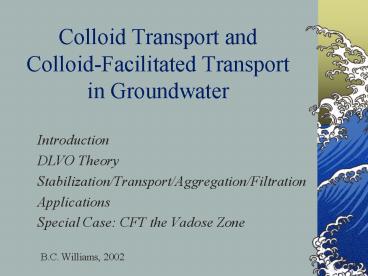Colloid Transport and Colloid-Facilitated Transport in Groundwater - PowerPoint PPT Presentation
1 / 23
Title:
Colloid Transport and Colloid-Facilitated Transport in Groundwater
Description:
Colloid Transport and Colloid-Facilitated Transport in Groundwater Introduction DLVO Theory Stabilization/Transport/Aggregation/Filtration Applications – PowerPoint PPT presentation
Number of Views:1632
Avg rating:3.0/5.0
Title: Colloid Transport and Colloid-Facilitated Transport in Groundwater
1
Colloid Transport and Colloid-Facilitated
Transportin Groundwater
- Introduction
- DLVO Theory
- Stabilization/Transport/Aggregation/Filtration
- Applications
- Special Case CFT the Vadose Zone
B.C. Williams, 2002
2
Colloids Defined
- Particles with diameters lt 10 micron, lt 0.45 µ
- Mineral detrital(as deposited) or autigenic
(from matrix) - Layer silicates
- Silica Rich Particles
- Iron oxides
- Organic e.g. humic macromolecules
- Humic macromolecules
- Biocolloids bacteria and viruses
3
(No Transcript)
4
Groundwater Transport in General
- Usual conceptual model for groundwater transport
as follows - Dissolved phase
- Adsorbed phase (onto soil/rock matrix)
- How a given chemical partitions into these two
phases is represented by the partition
coefficient, Kd.
5
Groundwater Transport Including
Colloid-Facilitated Transport
- Three phases
- Dissolved phase
- Adsorbed phase (onto soil/rock matrix)
- Adsorbed onto mobile particles
6
Colloid-Facilitated Groundwater Transport
Solid matrix
mobile colloid
Adsorbed
Dissolved
7
DLVO TheoryDerjaguin, Landau, Verwey, Overbeek
- The stability of a homogeneous colloidal
suspension depends upon (stabilitydispersed) - Van der Waals attractive forces (promote
aggregation) - Electrostatic repulsive forces that drive
particles apart - If electrostatic dominates, particles are
electrostatically stabilized (dispersed)
8
DLVO - stabilized
- Colloids are stabilized (in suspension) when
- Double layers expand (by decreasing electrolyte
concentration, decreasing ionic strength - Net particle charge ? 0
- Colloids coagulate/aggregate when
- Double layer shrinks because of increasing ionic
strength
9
Challenges to DLVO
- Hot controversy in literature on whether spheres
of like charge always repel. Experimental
evidence that colloidal electrostatic
interactions include a long-ranged attractive
component. - http//griergroup.uchicago.edu/grier/leshouches2/
leshouches2.html - http//griergroup.uchicago.edu/grier/comment3b/
10
Stabilization and sorbable species
- Sorbed species can influence surface charge, and
therefore stability (end of DLVO discussion) - Sorbed species can also be mobilized if the
colloid is mobilized through the soil/rock matrix
(colloid-facilitated transport!)
11
Colloid Transport in General(Saturated and
Unsaturated GW)
- Detachment / Mobilization / Suspension
- Stabilization
- Transport
- Aggregation / Filtration / Straining
12
Detachment/Mobilization/Suspension
- Colloids can detach from matrix
- Biogeochemical weathering
- Precipitation from solution (thermodyn)
- Biocolloids or humics flushed from shallow zones
- If cementing agents dissolve
- If stable aggregates deflocculate
13
Transport
- More likely if colloid is neg. charged, because
most soil/rock matrices are neg. - Transport optimal if
- Slow interpore transport rate few collisions
with side surfaces - High velocities in preferential pathways
- In preferential pathways, may have faster travel
times than ambient gw flows
14
Stabilization/Aggregation
- Aggregation occurs when double layer shrinks due
to increasing ionic strength (slide 6)
15
Filtering / Straining
- Physical filtering due to size, geometry
- Physicochemical straining surface chemical
attraction to matrix - Cementation agents (iron oxides, carbonates,
silica)
16
Applications
- Many engineering ramifications of passage versus
filtration - Colloid-facilitated transport how a
low-solubility (strongly-sorbed!) contaminant can
travel miles from the source
17
Engineering Applications
- Wastewater sand filters removal is good,
too-small particles clog - Roads clogging of drain filters ? force buildup
? failure - Dams matrix piping ? erosion ? 26 of earth dam
failures - ref Reddi, 1997
18
Engineering Applications, cont.
- Petroleum Extraction permeability reduction
termed formation damage - Slurry Walls very fines filtered by fines is
considered good - Lining of Lakes/Reservoirs ditto
- ref Reddi, 1997
19
Colloid-Facilitated Transport
- When a highly sorptive contaminant (constituent)
is adsorbed onto colloids - Contaminant of interest must have as high or
higher affinity to sorb as other possible
constituents - Colloid may have patches of surface coatings
(ferric, aluminum or manganese oxyhydroxides)
that are best sites
20
Colloid Transport in the Unsaturated Zone
- Colloids may be strained, or retarded, if
moisture content reduced so that water films have
thickness less than colloid diameter - Colloids may sorb to the air/water interface
- Called partitioning same Kd.concept
21
Colloid Transport in the Unsaturated ZoneOngoing
Research
- Film Straining of Colloids
- http//www.lbl.gov/jwan/film_straining/film_strai
ning.html - http//www.lbl.gov/jwan/particles_film/particles_
film.html - Colloids Sorbing to the Air-Water Interface
- http//www.lbl.gov/jwan/colloid_partition/colloid
_partitioning.html
22
References
- Johnson, P.R., Sun, N., and Elimelech, M., 1996.
Colloid Transport in Geochemically
Heterogeneous Porous Media, Environmental
Science and Technology, 30, 3284-3293. - Reddi, L. N., 1997. Particle Transport in Soils
Review of Significant Processes in Infrastructure
Systems. J. Infrastructure Systems. 3, 78-86. - McCarthy, J.F., Zachara, J.M., 1989.
Subsurface Transport of Contaminants.
Environmental Science and Technology, 23,
496-502. - Wan, J. T.K. Tokunaga, 1998. "Measuring
partition coefficients of colloids at air-water
interfaces", Environ. Sci. Technol, 32,
p3293-3298, - Wan, J., Wilson, J.L., 1994. Colloid transport
in unsaturated porous media. Water Resources
Research. 30, 857-864.
23
Acknowledgements
- Jason Shira, MS Student
- George Redden, INEEL































